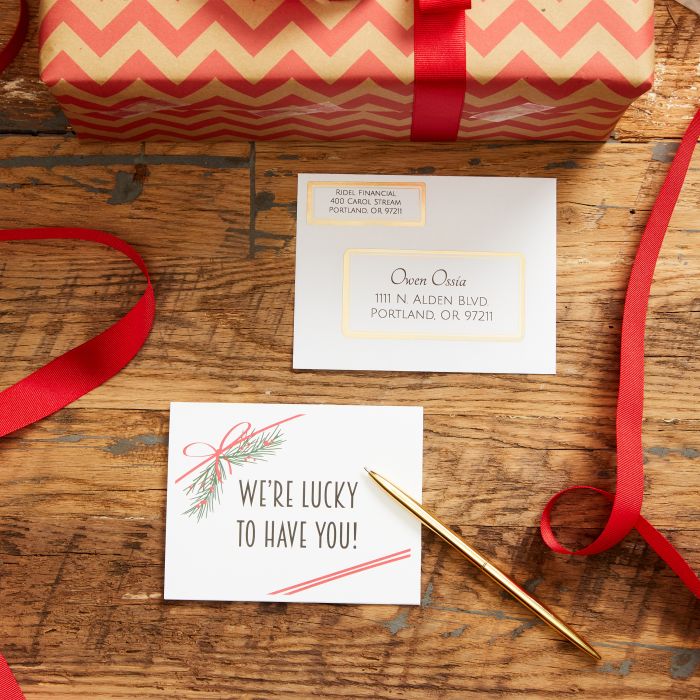
Christmas Cards 2024: Why Your Business Should Send Them
Mistakes to avoid & tips for creating a perfect business Christmas card
Other articles you might like:
The holiday season is a time of joy, goodwill, and connection. It’s also a significant opportunity for businesses to strengthen relationships with clients, partners, and employees. One timeless and thoughtful way to achieve this is through the exchange of holiday greetings. Sending a personalized, heartfelt company Christmas card can leave a lasting impression and foster goodwill, making it a valuable strategy to consider. In this article, we explain the importance of a Christmas business card, creative tips to make them stand out from all the junk mail, what to write on your cards, and common mistakes to avoid.
Why should you send a Christmas business card?

Company Christmas cards are a meaningful way to show appreciation to clients, partners, and customers. It shows that your business values the relationship you’ve built throughout the year.
In the digital age, receiving a physical greeting card carries a personal touch that emails and social media messages just can’t match. Most people display their holiday cards until the season is over. It’s a great way to keep your company top-of-mind for a few more weeks and it shows you’ve taken the time to connect on a more personal basis.
Physical greeting cards also help with brand reinforcement. Customized cards can serve as a subtle branding tool by including your company logo and colors. Don’t go overboard with a giant logo on the front of the card. Place a logo or your company name in a smaller font where it doesn’t take away your message or handwritten note.
Sending holiday cards to potential clients or prospective partners is an excellent way to initiate or strengthen a new business relationship. It can open the door for future collaboration and also keep you and your business top of mind.
Benefits of Christmas cards in 2024
By acknowledging your clients, partners, and customers during the holiday season, you can strengthen their loyalty and commitment to your brand or company. Customers and clients who feel valued are more likely to stay loyal to your business. Sending a personalized Christmas card can help you maintain long-term client relationships.
For your vendors and employees, recognizing them for their work and dedication to helping keep your business running, can increase their job satisfaction and morale, ultimately leading to improved productivity.
Tips for creating the ideal Christmas card

Personalization is key: Use recipient names and personalize messages whenever possible. This makes the card feel more special and meaningful.
Quality over quantity: Opt for high-quality cardstock and professional printing. A well-crafted card reflects positively on your business.
Showcase your brand: Include your company logo or colors in the card’s design. Make sure the card is on-brand to reinforce your business identity.
Handwritten note: Consider including a short, handwritten note or signature to add a personal touch and authenticity. Just handwriting “Best Wishes” can show you care enough to take the time to address the recipient. If you have the time, adding a personal anecdote is a great relationship builder.
Charity collaboration: Show your commitment to social responsibility by donating a portion of your Christmas card budget to a charitable cause and mentioning it in the card.
Digital integration: Pair physical cards with digital components like QR codes or personalized video messages for a modern twist.
Timing matters: Send your cards early enough to ensure they arrive before the holiday rush but not so early that they get lost in the pre-holiday chaos.
What do you write on a Christmas business card?

Crafting the perfect Christmas card sayings can be a fun and gratifying task in itself. But remember to still keep your message professional. If possible, personalize the card with the customer’s name or a brief personal note to make it more meaningful.
Begin with a warm and cheerful holiday greeting such as “Happy Holidays,” or “Season’s Greetings.” If you are unsure of the holiday your client might celebrate, it’s better to stick with a generic message. If you can and your list isn’t too extensive, personalize the card with the recipient’s name.
After your holiday greeting, add a personalized message thanking your customer or client for their business relationship. For example, you can say something like, “We loved working with you this year and are grateful for your partnership.”
Then you can extend sentiments for the coming year with something such as, “Wishing you a prosperous and successful New Year.”
Finally, close it out with the company’s signature. For an even more personal touch, personally sign the cards instead of having your company name printed.
Common holiday card mistakes
Sending holiday cards may seem like a simple task but there are many pitfalls that can make your thoughtful gesture turn into a waste of time and money or hurt feelings. Here are some common mistakes businesses should avoid when sending out holiday cards:
Don’t have out-of-date contacts
Make sure all of your contact information is current, names are spelled correctly, and there are no duplicates. If you’re going to spend the time and money sending cards, you’re just throwing it all away when you make a critical error. Receiving two cards from the same business shows your business may not be keeping all of its records up to date.
Also, while you may deal with one person at a particular business, in many cases, this person has a partner or boss. It’s a good idea to send a card to both. It not only shows your appreciation but it can also help out your client at his place of work.
Don’t send cards too late
It can take time to get your cards organized and ready so order them as early as possible. This will ensure you have extra time to write personal notes, as well as ensuring they get sent in plenty of time before the holiday shipping rush. Sending your cards after Thanksgiving, in early December, is ideal.
Don’t make a sales pitch
Leave sales and promotions for another time. Your holiday cards should only be focused on relationship building, not selling. Don’t include a promotion or new item pitch. If you want to include a gift card or token of appreciation, that’s great, but don’t send a 15% off coupon or a BOGO deal.
Don’t be afraid of personalization
If you know the people you are sending cards to have a certain religious affiliation, don’t be afraid to send cards for Christmas, Hanukkah, or Kawanza. Many businesses don’t want to offend anyone, but if you know for certain your clients’ beliefs it can be a way to stand out from the crowd and make them feel special that you’re honoring their holiday or beliefs.
Don’t forget the other 11 months
If you really want to get their attention and let them know you care, try sending cards at other times of the year to show appreciation. If you know someone’s birthday, make a note of it and send a card. Or send a note at the beginning of spring or the start of summer. If your client loves baseball, send them a card on opening day. There are no rules when it comes to growing a work relationship. (Well, maybe they’re some rules).
Wrapping it up
Christmas cards for businesses are more than just an old tradition. They’re an easy way to build relationships, boost brand recognition and loyalty, and leave a lasting impression on clients, partners, and employees.
When you send out thoughtful and creative greeting cards you can set the stage for a good working relationship for the year ahead. So don’t underestimate the thoughtful gesture of sending a card and spreading a little corporate cheer.
If you need any help designing or ordering your holiday or Christmas cards for your business, reach out to our amazing customer care team in California at (800) 942-8379. They can answer any questions you might have.



